Comparative Analysis: U.S. & Great Britain Healthcare Systems
VerifiedAdded on 2023/06/15
|6
|1391
|405
Report
AI Summary
This report provides a comparative analysis of the healthcare systems in the United States and Great Britain, focusing on access for children, unemployed individuals, and retirees. It examines key differences in medication coverage, referral requirements for specialists, and coverage for preexisting conditions. The report also discusses the financial implications for patients in both countries, highlighting variations in out-of-pocket expenses and overall healthcare spending. Ultimately, the analysis suggests that both countries can learn from each other to improve the robustness and quality of their respective healthcare systems, ensuring more responsive and high-quality care delivery.
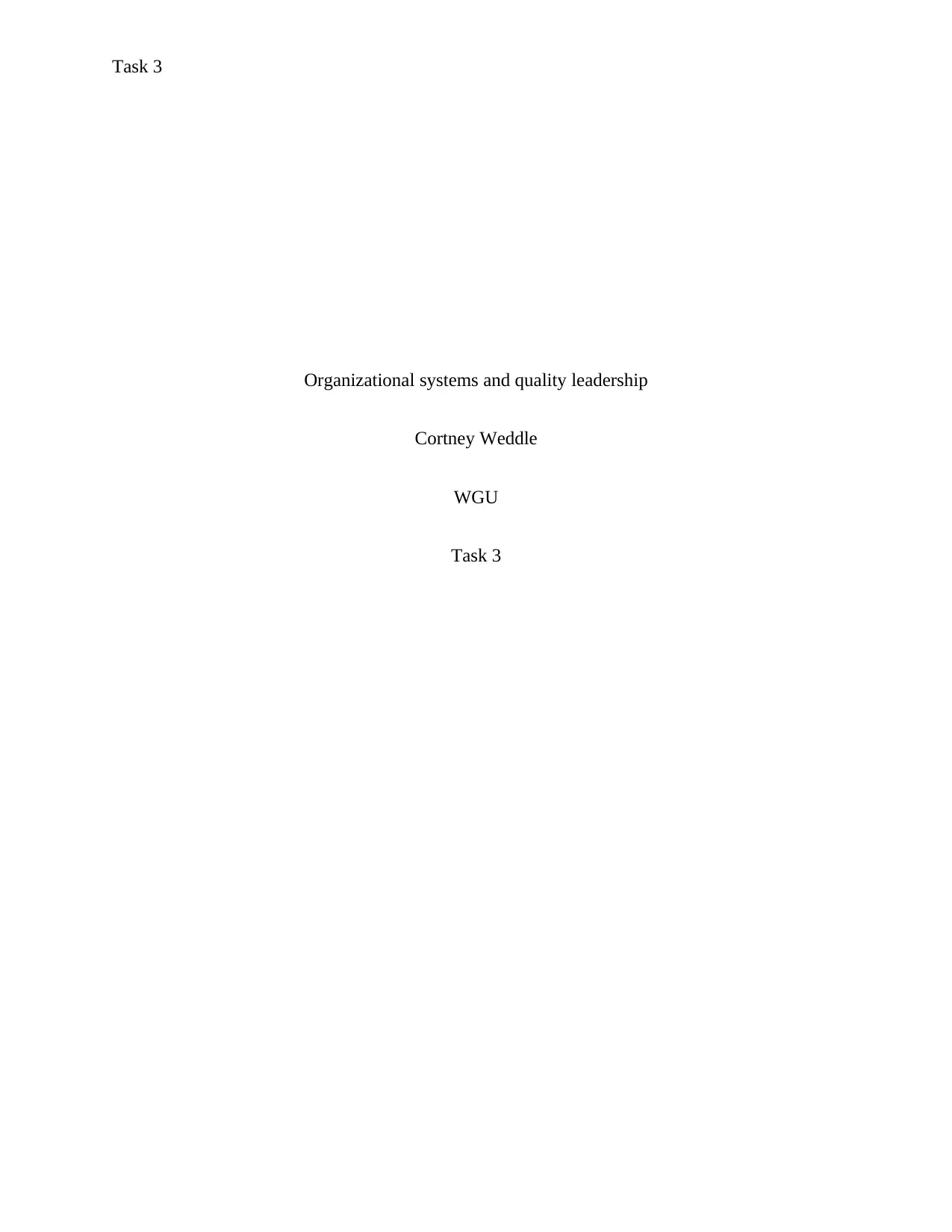
Task 3
Organizational systems and quality leadership
Cortney Weddle
WGU
Task 3
Organizational systems and quality leadership
Cortney Weddle
WGU
Task 3
Paraphrase This Document
Need a fresh take? Get an instant paraphrase of this document with our AI Paraphraser
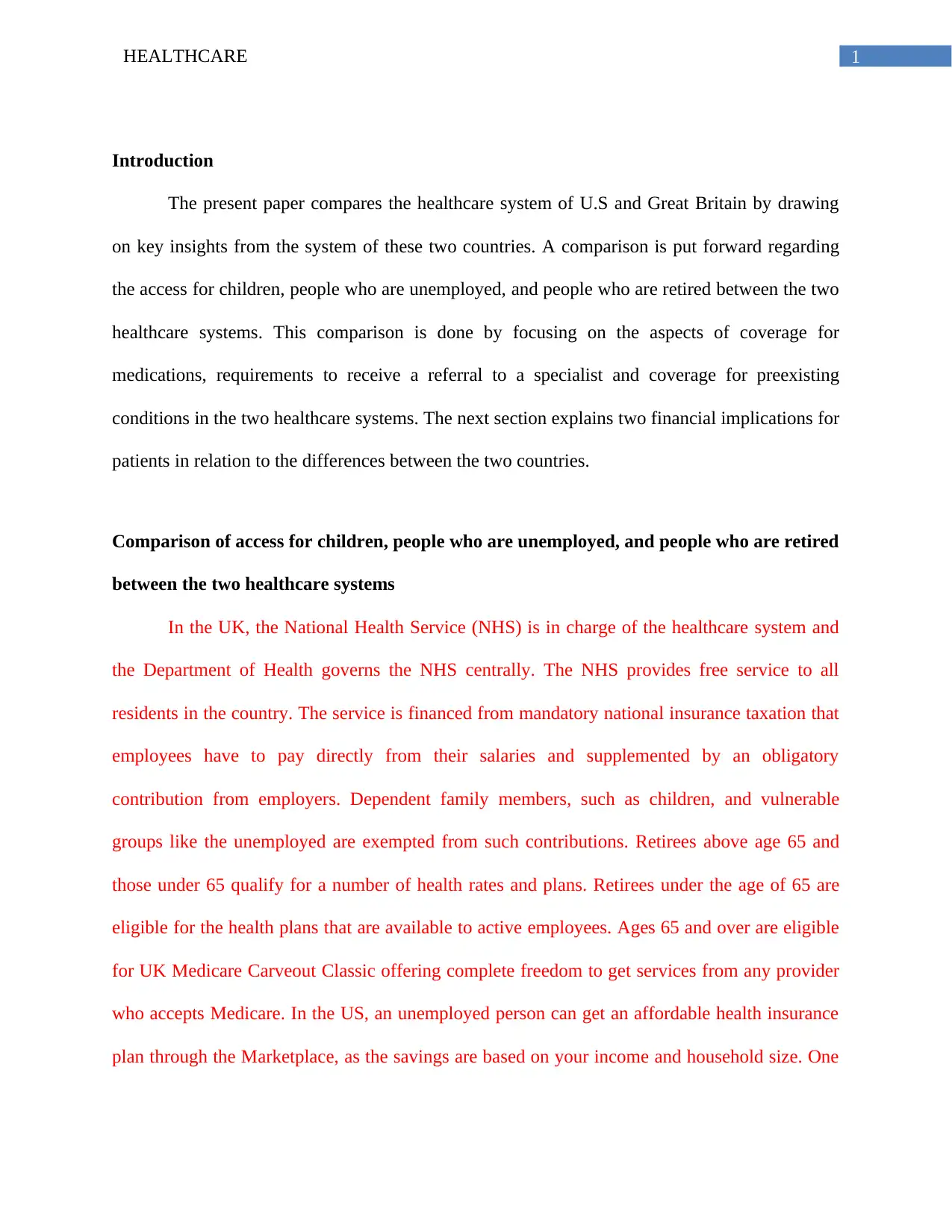
1HEALTHCARE
Introduction
The present paper compares the healthcare system of U.S and Great Britain by drawing
on key insights from the system of these two countries. A comparison is put forward regarding
the access for children, people who are unemployed, and people who are retired between the two
healthcare systems. This comparison is done by focusing on the aspects of coverage for
medications, requirements to receive a referral to a specialist and coverage for preexisting
conditions in the two healthcare systems. The next section explains two financial implications for
patients in relation to the differences between the two countries.
Comparison of access for children, people who are unemployed, and people who are retired
between the two healthcare systems
In the UK, the National Health Service (NHS) is in charge of the healthcare system and
the Department of Health governs the NHS centrally. The NHS provides free service to all
residents in the country. The service is financed from mandatory national insurance taxation that
employees have to pay directly from their salaries and supplemented by an obligatory
contribution from employers. Dependent family members, such as children, and vulnerable
groups like the unemployed are exempted from such contributions. Retirees above age 65 and
those under 65 qualify for a number of health rates and plans. Retirees under the age of 65 are
eligible for the health plans that are available to active employees. Ages 65 and over are eligible
for UK Medicare Carveout Classic offering complete freedom to get services from any provider
who accepts Medicare. In the US, an unemployed person can get an affordable health insurance
plan through the Marketplace, as the savings are based on your income and household size. One
Introduction
The present paper compares the healthcare system of U.S and Great Britain by drawing
on key insights from the system of these two countries. A comparison is put forward regarding
the access for children, people who are unemployed, and people who are retired between the two
healthcare systems. This comparison is done by focusing on the aspects of coverage for
medications, requirements to receive a referral to a specialist and coverage for preexisting
conditions in the two healthcare systems. The next section explains two financial implications for
patients in relation to the differences between the two countries.
Comparison of access for children, people who are unemployed, and people who are retired
between the two healthcare systems
In the UK, the National Health Service (NHS) is in charge of the healthcare system and
the Department of Health governs the NHS centrally. The NHS provides free service to all
residents in the country. The service is financed from mandatory national insurance taxation that
employees have to pay directly from their salaries and supplemented by an obligatory
contribution from employers. Dependent family members, such as children, and vulnerable
groups like the unemployed are exempted from such contributions. Retirees above age 65 and
those under 65 qualify for a number of health rates and plans. Retirees under the age of 65 are
eligible for the health plans that are available to active employees. Ages 65 and over are eligible
for UK Medicare Carveout Classic offering complete freedom to get services from any provider
who accepts Medicare. In the US, an unemployed person can get an affordable health insurance
plan through the Marketplace, as the savings are based on your income and household size. One
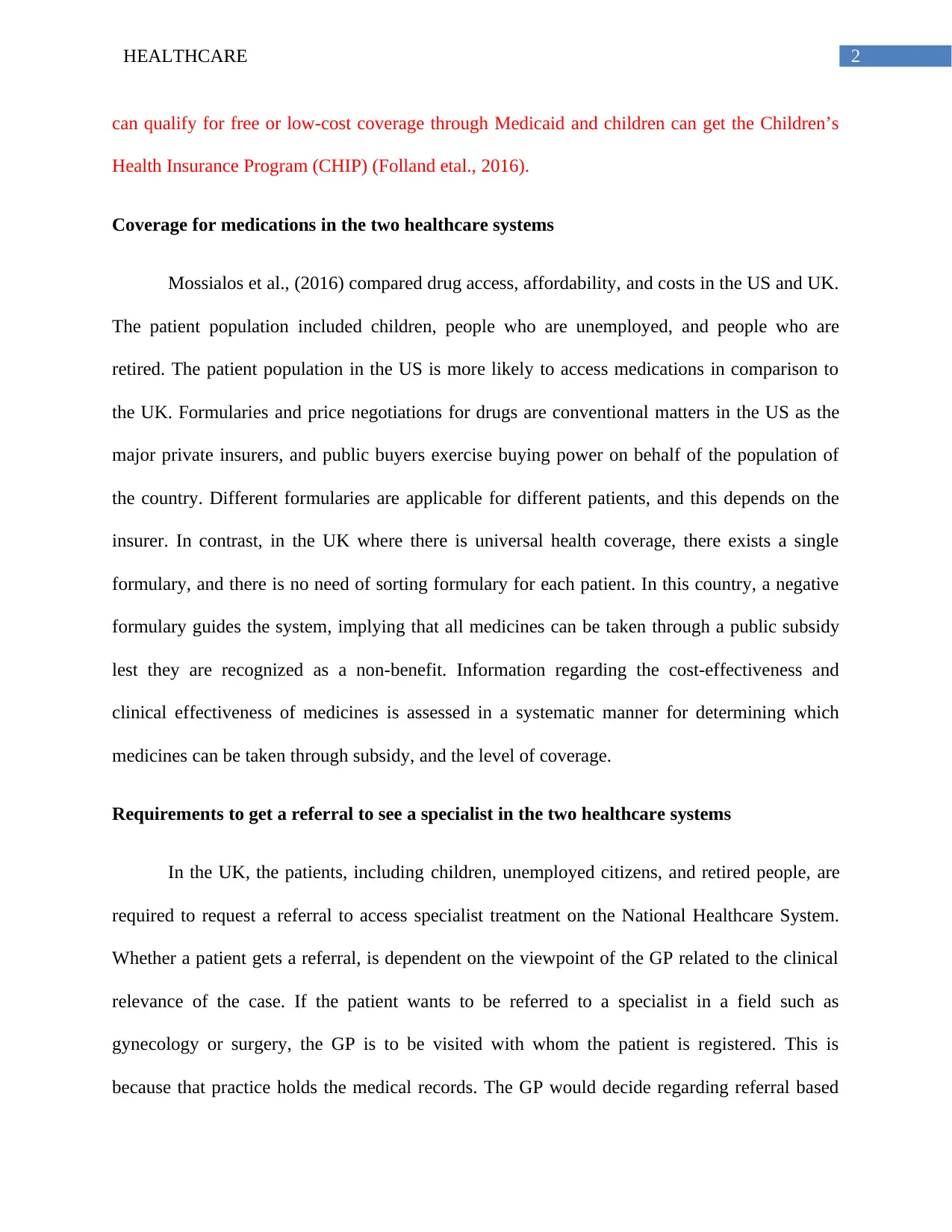
2HEALTHCARE
can qualify for free or low-cost coverage through Medicaid and children can get the Children’s
Health Insurance Program (CHIP) (Folland etal., 2016).
Coverage for medications in the two healthcare systems
Mossialos et al., (2016) compared drug access, affordability, and costs in the US and UK.
The patient population included children, people who are unemployed, and people who are
retired. The patient population in the US is more likely to access medications in comparison to
the UK. Formularies and price negotiations for drugs are conventional matters in the US as the
major private insurers, and public buyers exercise buying power on behalf of the population of
the country. Different formularies are applicable for different patients, and this depends on the
insurer. In contrast, in the UK where there is universal health coverage, there exists a single
formulary, and there is no need of sorting formulary for each patient. In this country, a negative
formulary guides the system, implying that all medicines can be taken through a public subsidy
lest they are recognized as a non-benefit. Information regarding the cost-effectiveness and
clinical effectiveness of medicines is assessed in a systematic manner for determining which
medicines can be taken through subsidy, and the level of coverage.
Requirements to get a referral to see a specialist in the two healthcare systems
In the UK, the patients, including children, unemployed citizens, and retired people, are
required to request a referral to access specialist treatment on the National Healthcare System.
Whether a patient gets a referral, is dependent on the viewpoint of the GP related to the clinical
relevance of the case. If the patient wants to be referred to a specialist in a field such as
gynecology or surgery, the GP is to be visited with whom the patient is registered. This is
because that practice holds the medical records. The GP would decide regarding referral based
can qualify for free or low-cost coverage through Medicaid and children can get the Children’s
Health Insurance Program (CHIP) (Folland etal., 2016).
Coverage for medications in the two healthcare systems
Mossialos et al., (2016) compared drug access, affordability, and costs in the US and UK.
The patient population included children, people who are unemployed, and people who are
retired. The patient population in the US is more likely to access medications in comparison to
the UK. Formularies and price negotiations for drugs are conventional matters in the US as the
major private insurers, and public buyers exercise buying power on behalf of the population of
the country. Different formularies are applicable for different patients, and this depends on the
insurer. In contrast, in the UK where there is universal health coverage, there exists a single
formulary, and there is no need of sorting formulary for each patient. In this country, a negative
formulary guides the system, implying that all medicines can be taken through a public subsidy
lest they are recognized as a non-benefit. Information regarding the cost-effectiveness and
clinical effectiveness of medicines is assessed in a systematic manner for determining which
medicines can be taken through subsidy, and the level of coverage.
Requirements to get a referral to see a specialist in the two healthcare systems
In the UK, the patients, including children, unemployed citizens, and retired people, are
required to request a referral to access specialist treatment on the National Healthcare System.
Whether a patient gets a referral, is dependent on the viewpoint of the GP related to the clinical
relevance of the case. If the patient wants to be referred to a specialist in a field such as
gynecology or surgery, the GP is to be visited with whom the patient is registered. This is
because that practice holds the medical records. The GP would decide regarding referral based
⊘ This is a preview!⊘
Do you want full access?
Subscribe today to unlock all pages.

Trusted by 1+ million students worldwide
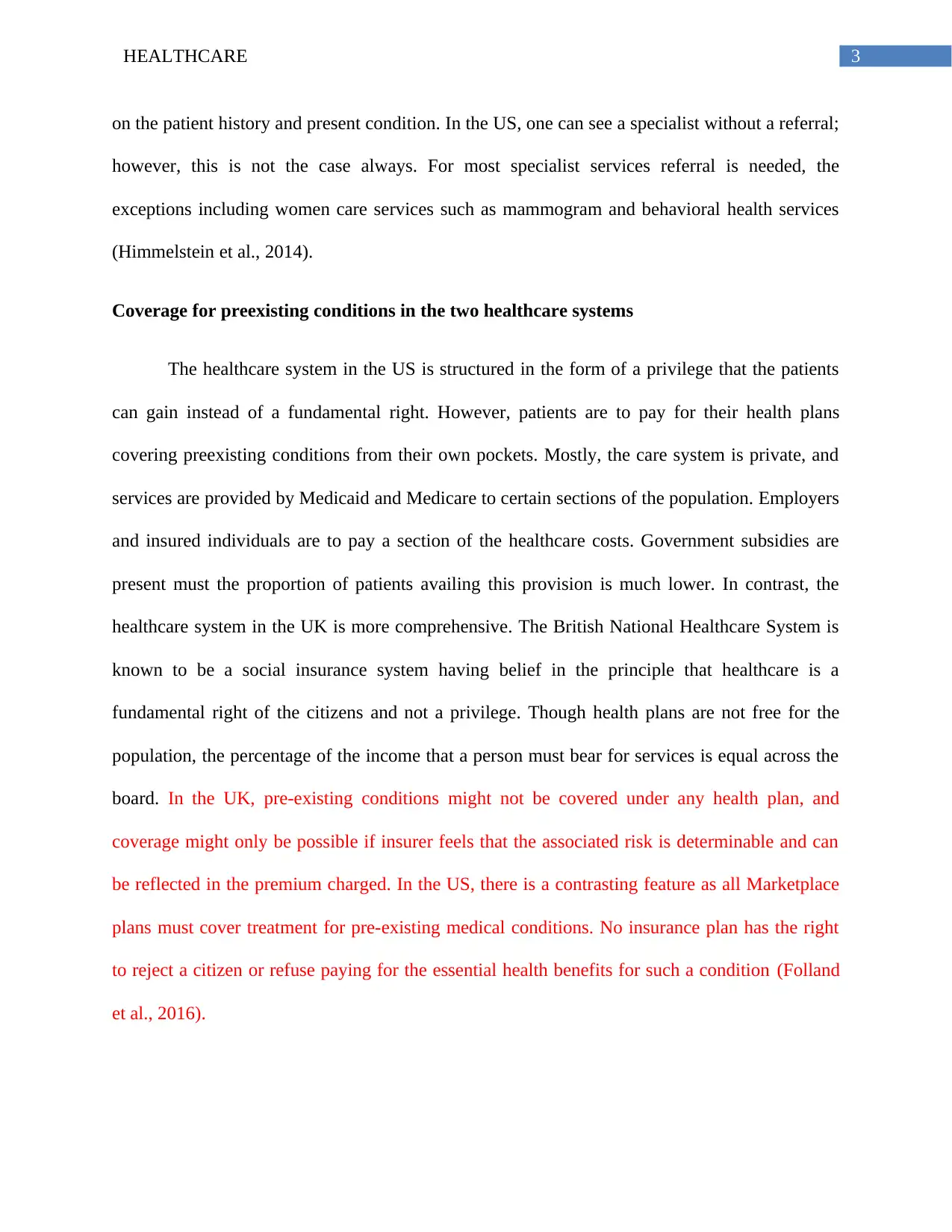
3HEALTHCARE
on the patient history and present condition. In the US, one can see a specialist without a referral;
however, this is not the case always. For most specialist services referral is needed, the
exceptions including women care services such as mammogram and behavioral health services
(Himmelstein et al., 2014).
Coverage for preexisting conditions in the two healthcare systems
The healthcare system in the US is structured in the form of a privilege that the patients
can gain instead of a fundamental right. However, patients are to pay for their health plans
covering preexisting conditions from their own pockets. Mostly, the care system is private, and
services are provided by Medicaid and Medicare to certain sections of the population. Employers
and insured individuals are to pay a section of the healthcare costs. Government subsidies are
present must the proportion of patients availing this provision is much lower. In contrast, the
healthcare system in the UK is more comprehensive. The British National Healthcare System is
known to be a social insurance system having belief in the principle that healthcare is a
fundamental right of the citizens and not a privilege. Though health plans are not free for the
population, the percentage of the income that a person must bear for services is equal across the
board. In the UK, pre-existing conditions might not be covered under any health plan, and
coverage might only be possible if insurer feels that the associated risk is determinable and can
be reflected in the premium charged. In the US, there is a contrasting feature as all Marketplace
plans must cover treatment for pre-existing medical conditions. No insurance plan has the right
to reject a citizen or refuse paying for the essential health benefits for such a condition (Folland
et al., 2016).
on the patient history and present condition. In the US, one can see a specialist without a referral;
however, this is not the case always. For most specialist services referral is needed, the
exceptions including women care services such as mammogram and behavioral health services
(Himmelstein et al., 2014).
Coverage for preexisting conditions in the two healthcare systems
The healthcare system in the US is structured in the form of a privilege that the patients
can gain instead of a fundamental right. However, patients are to pay for their health plans
covering preexisting conditions from their own pockets. Mostly, the care system is private, and
services are provided by Medicaid and Medicare to certain sections of the population. Employers
and insured individuals are to pay a section of the healthcare costs. Government subsidies are
present must the proportion of patients availing this provision is much lower. In contrast, the
healthcare system in the UK is more comprehensive. The British National Healthcare System is
known to be a social insurance system having belief in the principle that healthcare is a
fundamental right of the citizens and not a privilege. Though health plans are not free for the
population, the percentage of the income that a person must bear for services is equal across the
board. In the UK, pre-existing conditions might not be covered under any health plan, and
coverage might only be possible if insurer feels that the associated risk is determinable and can
be reflected in the premium charged. In the US, there is a contrasting feature as all Marketplace
plans must cover treatment for pre-existing medical conditions. No insurance plan has the right
to reject a citizen or refuse paying for the essential health benefits for such a condition (Folland
et al., 2016).
Paraphrase This Document
Need a fresh take? Get an instant paraphrase of this document with our AI Paraphraser
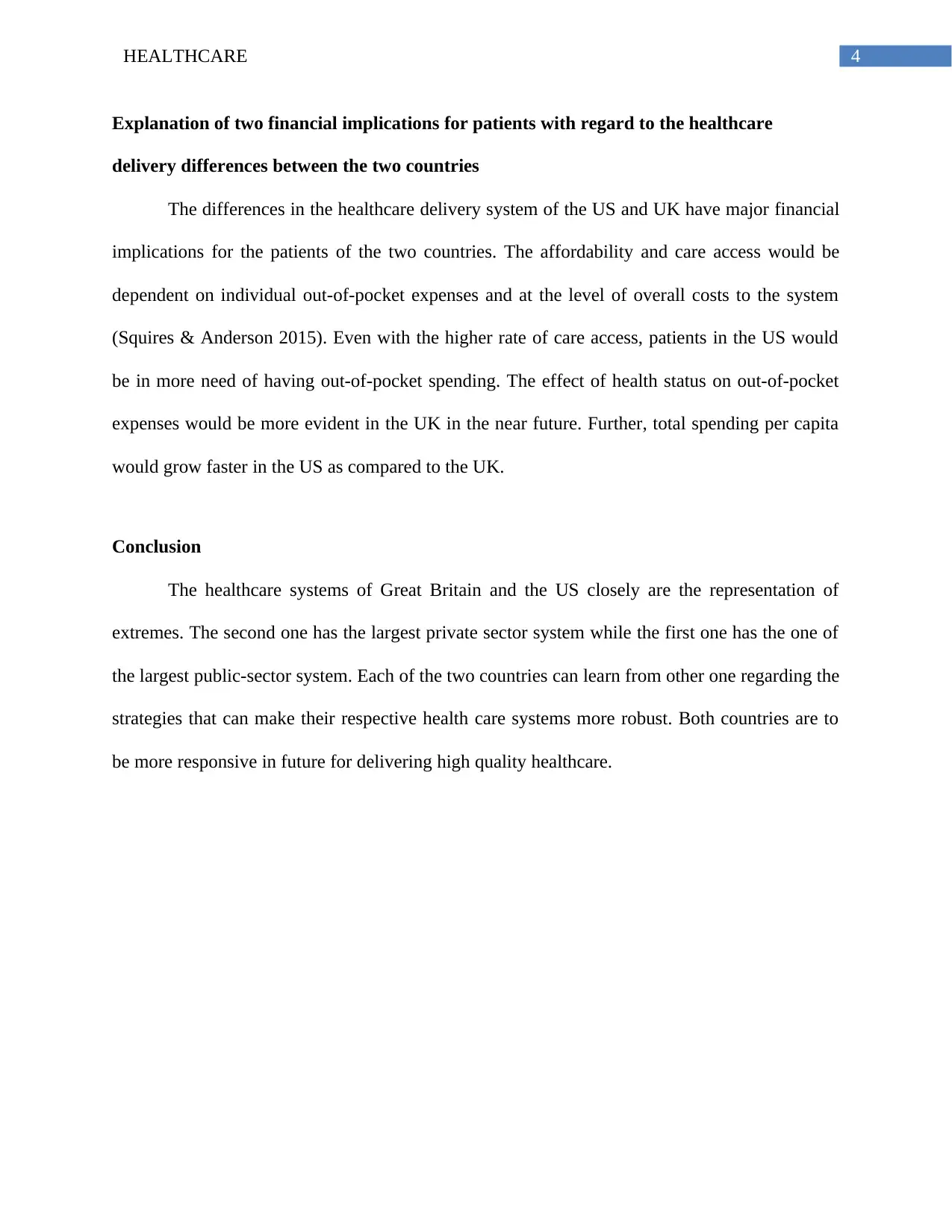
4HEALTHCARE
Explanation of two financial implications for patients with regard to the healthcare
delivery differences between the two countries
The differences in the healthcare delivery system of the US and UK have major financial
implications for the patients of the two countries. The affordability and care access would be
dependent on individual out-of-pocket expenses and at the level of overall costs to the system
(Squires & Anderson 2015). Even with the higher rate of care access, patients in the US would
be in more need of having out-of-pocket spending. The effect of health status on out-of-pocket
expenses would be more evident in the UK in the near future. Further, total spending per capita
would grow faster in the US as compared to the UK.
Conclusion
The healthcare systems of Great Britain and the US closely are the representation of
extremes. The second one has the largest private sector system while the first one has the one of
the largest public-sector system. Each of the two countries can learn from other one regarding the
strategies that can make their respective health care systems more robust. Both countries are to
be more responsive in future for delivering high quality healthcare.
Explanation of two financial implications for patients with regard to the healthcare
delivery differences between the two countries
The differences in the healthcare delivery system of the US and UK have major financial
implications for the patients of the two countries. The affordability and care access would be
dependent on individual out-of-pocket expenses and at the level of overall costs to the system
(Squires & Anderson 2015). Even with the higher rate of care access, patients in the US would
be in more need of having out-of-pocket spending. The effect of health status on out-of-pocket
expenses would be more evident in the UK in the near future. Further, total spending per capita
would grow faster in the US as compared to the UK.
Conclusion
The healthcare systems of Great Britain and the US closely are the representation of
extremes. The second one has the largest private sector system while the first one has the one of
the largest public-sector system. Each of the two countries can learn from other one regarding the
strategies that can make their respective health care systems more robust. Both countries are to
be more responsive in future for delivering high quality healthcare.
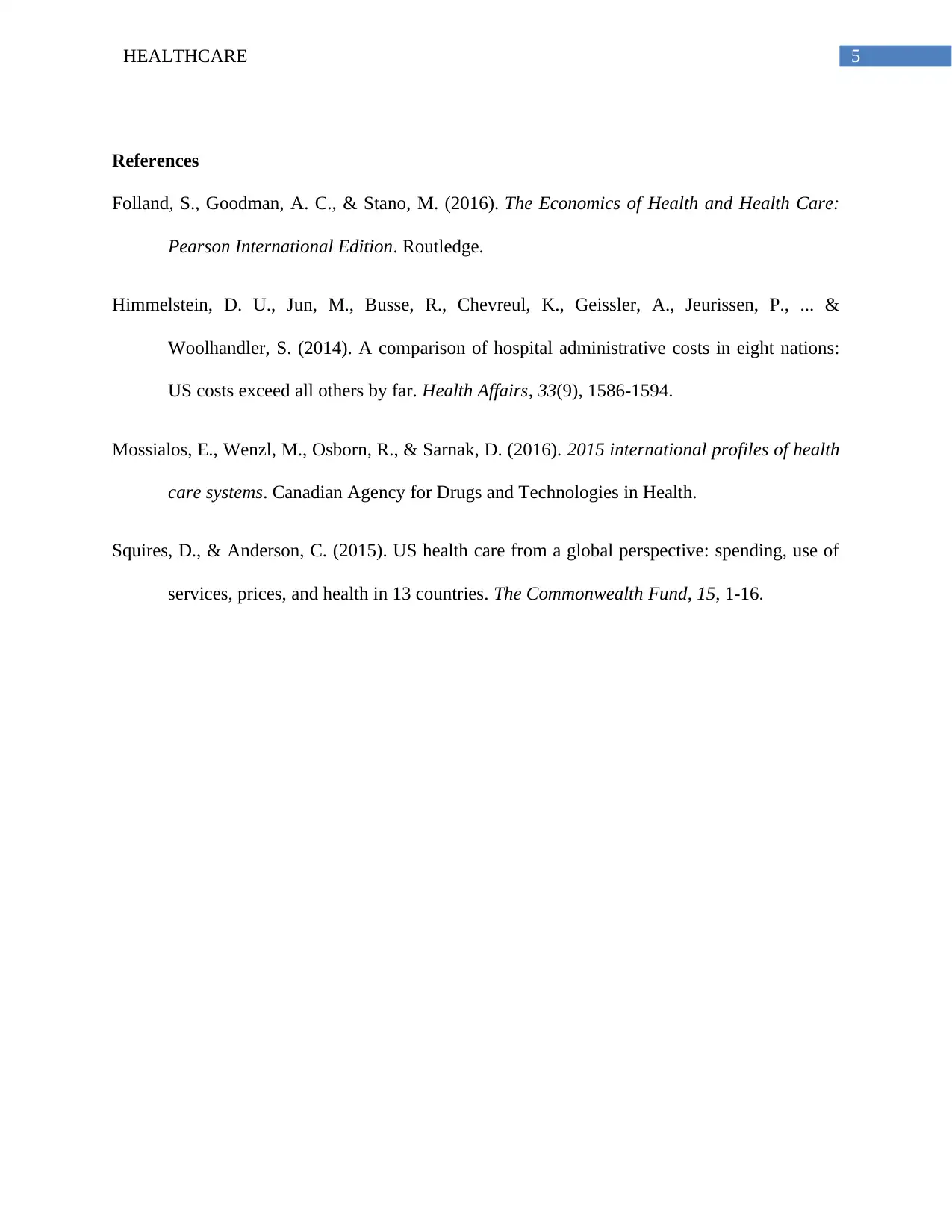
5HEALTHCARE
References
Folland, S., Goodman, A. C., & Stano, M. (2016). The Economics of Health and Health Care:
Pearson International Edition. Routledge.
Himmelstein, D. U., Jun, M., Busse, R., Chevreul, K., Geissler, A., Jeurissen, P., ... &
Woolhandler, S. (2014). A comparison of hospital administrative costs in eight nations:
US costs exceed all others by far. Health Affairs, 33(9), 1586-1594.
Mossialos, E., Wenzl, M., Osborn, R., & Sarnak, D. (2016). 2015 international profiles of health
care systems. Canadian Agency for Drugs and Technologies in Health.
Squires, D., & Anderson, C. (2015). US health care from a global perspective: spending, use of
services, prices, and health in 13 countries. The Commonwealth Fund, 15, 1-16.
References
Folland, S., Goodman, A. C., & Stano, M. (2016). The Economics of Health and Health Care:
Pearson International Edition. Routledge.
Himmelstein, D. U., Jun, M., Busse, R., Chevreul, K., Geissler, A., Jeurissen, P., ... &
Woolhandler, S. (2014). A comparison of hospital administrative costs in eight nations:
US costs exceed all others by far. Health Affairs, 33(9), 1586-1594.
Mossialos, E., Wenzl, M., Osborn, R., & Sarnak, D. (2016). 2015 international profiles of health
care systems. Canadian Agency for Drugs and Technologies in Health.
Squires, D., & Anderson, C. (2015). US health care from a global perspective: spending, use of
services, prices, and health in 13 countries. The Commonwealth Fund, 15, 1-16.
⊘ This is a preview!⊘
Do you want full access?
Subscribe today to unlock all pages.

Trusted by 1+ million students worldwide
1 out of 6
Related Documents
Your All-in-One AI-Powered Toolkit for Academic Success.
+13062052269
info@desklib.com
Available 24*7 on WhatsApp / Email
![[object Object]](/_next/static/media/star-bottom.7253800d.svg)
Unlock your academic potential
Copyright © 2020–2025 A2Z Services. All Rights Reserved. Developed and managed by ZUCOL.





